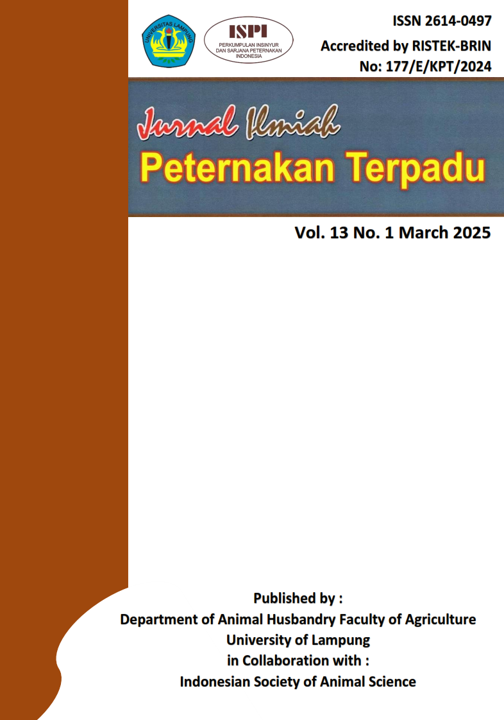Development Strategy for Hybrid Duck Farming in Besuki District Situbondo Regency
DOI:
https://doi.org/10.23960/jipt.v13i1.p61-69 Abstract View: 221
Abstract View: 221
Keywords:
Hybrid Duck, Development Strategy, IFAS matrix, EFAS matrix, SWOT AnalysisAbstract
This study aims to analyze the right development strategy for the hybrid duck farming business in Besuki District and to find out how the influence of internal and external factors on the development of hybrid duck farming business in Besuki District. This study uses a descriptive research design by using questionnaires of the respondents. The data obtained were then analyzed using the IFAS matrix, EFAS matrix, SWOT diagram, and SWOT matrix. Based on the results of the study, in the IFAS matrix, product marketing that has not been maximized has the greatest influence whit a total score of 0,55, while in the EFAS matrix, the number of product requests that have the greatest influence is with a total score of 0,61. The results of the SWOT analysis show that the business position is in quadrant I, which means that the hybrid duck farming business in Besuki District has strong internal and external conditions. The development strategy that must be applied is the Growth Oriented Strategy (SO), where this strategy is made based on the company's mindset, namely by utilizing all forces to seize and take advantage of opportunities as much as possible. The strategies used are to increase the production of hybrid duck seedlings, utilize existing alternative feed, and maintain good relations between business actors.Downloads
References
Badan Pusat Statistik. 2016. Produksi dan Nilai Perikanan Menurut Jenis Ikan di Kabupaten Situbondo Tahun 2015-2016. Situbondo : Badan Pusat Statistik.
Badan Pusat Statistik. 2017. Populasi Unggas Menurut Kecamatan dan Jenis Unggas di Kabupaten Situbondo. Situbondo : Badan Pusat Statistik.
Badan Pusat Statistik. 2019. Produksi Padi menurut Kabupaten/Kota di Provinsi Jawa Timur. Jakarta : Badan Pusat Statistik.
Heryadi, A. Y. 2013. Profitabilitas Usaha Itik Pedaging di Desa Juluk Kecamatan Saronggi Kabupaten Sumenep. Jurnal Ilmu Peternakan 10 (10), 17-23.
Kementerian Pertanian, 2021. Statistik Peternakan dan Kesehatan Hewan. Jakarta : Direktorat Jenderal Peternakan dan Kesehatan Hewan Kementerian Pertanian RI.
Ketaren, P.P. 2002. Pengaruh Pemberian pakan terbatas terhadap Produktivitas Itik Silang Mojosari X Alabio (MA) selama 12 bulan produksi. Jurnal Peternakan Terapan Vol. 1 (1). 8-10.
Meni, E. 2018. Pengaruh Pemberian Tepung Ikan dengan Level yang Berbeda terhadap Pertumbuhan Itik Peking. Jurnal Fakultas Pertanian Universitas Timor, 3(1), 5–7.
Sujarweni, V. Wiratna. 2015. Metodologi Penelitian Bisnis & Ekonomi, Yogyakarta : Penerbit Pustaka Baru Press.
Wulyono, T., dan Daroini, A. (2013). Strategi Pengembangan Itik Dalam Rangka Peningkatan Pendapatan Peternak Di Kabupaten Kediri. Jurnal Manajemen Agribisnis 13 (2) : 17-3.
Downloads
Published
How to Cite
Issue
Section
License

Jurnal Ilmiah Peternakan Terpadu(JIPT) is licensed under a Creative Commons Attribution 4.0 International License.
Authors who publish with this journal agree to the following terms:
- Authors retain copyright and grant the journal right of first publication with the work simultaneously licensed under a Creative Commons Attribution License that allows others to share the work with an acknowledgement of the work's authorship and initial publication in this journal.
- Authors are able to enter into separate, additional contractual arrangements for the non-exclusive distribution of the journal's published version of the work (e.g., post it to an institutional repository or publish it in a book), with an acknowledgement of its initial publication in this journal.
- Authors are permitted and encouraged to post their work online (e.g., in institutional repositories or on their website) prior to and during the submission process, as it can lead to productive exchanges, as well as earlier and greater citation of published work (See The Effect of Open Access).





















